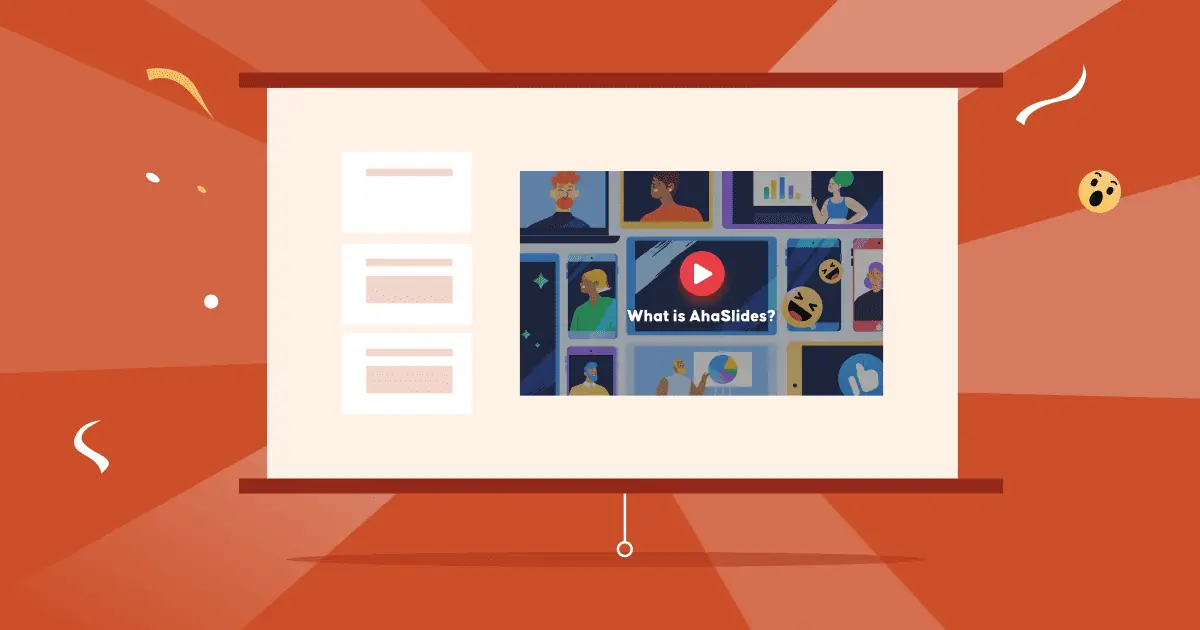초보자를 위한 토론 방법은? 논쟁은 정말 중요한 주제입니다. 한 번도 논쟁을 해본 적이 없다면, 무슨 일이 일어날지, 그리고 모든 사람 앞에서 어떻게 하면 완전히 어리둥절해 보이지 않을 수 있을지 생각하는 것만으로도 버거울 수 있습니다.
단상에 설 용기를 얻기 전에 배워야 할 것이 많습니다. 하지만 걱정하지 마세요. 이 초보자를 위한 토론 가이드는 다음 토론에서 승리하는 데 필요한 단계, 팁, 그리고 예시를 제공합니다. 자, 그럼 이 멋진 토론 팁들을 살펴보겠습니다!
차례
AhaSlides를 활용한 더 많은 팁
초보자를 위한 토론 방식(7단계)
전문가처럼 주장을 펼치는 방법을 알아보기 전에, 초보자 토론이 어떻게 진행되는지 먼저 알아야 합니다. 초보자를 위한 토론 7단계와 그 과정에서 해야 할 일을 확인해 보세요. 그러면 더 나은 토론자가 되는 방법을 완벽하게 이해하게 될 것입니다!
1. 목적이 정해진다
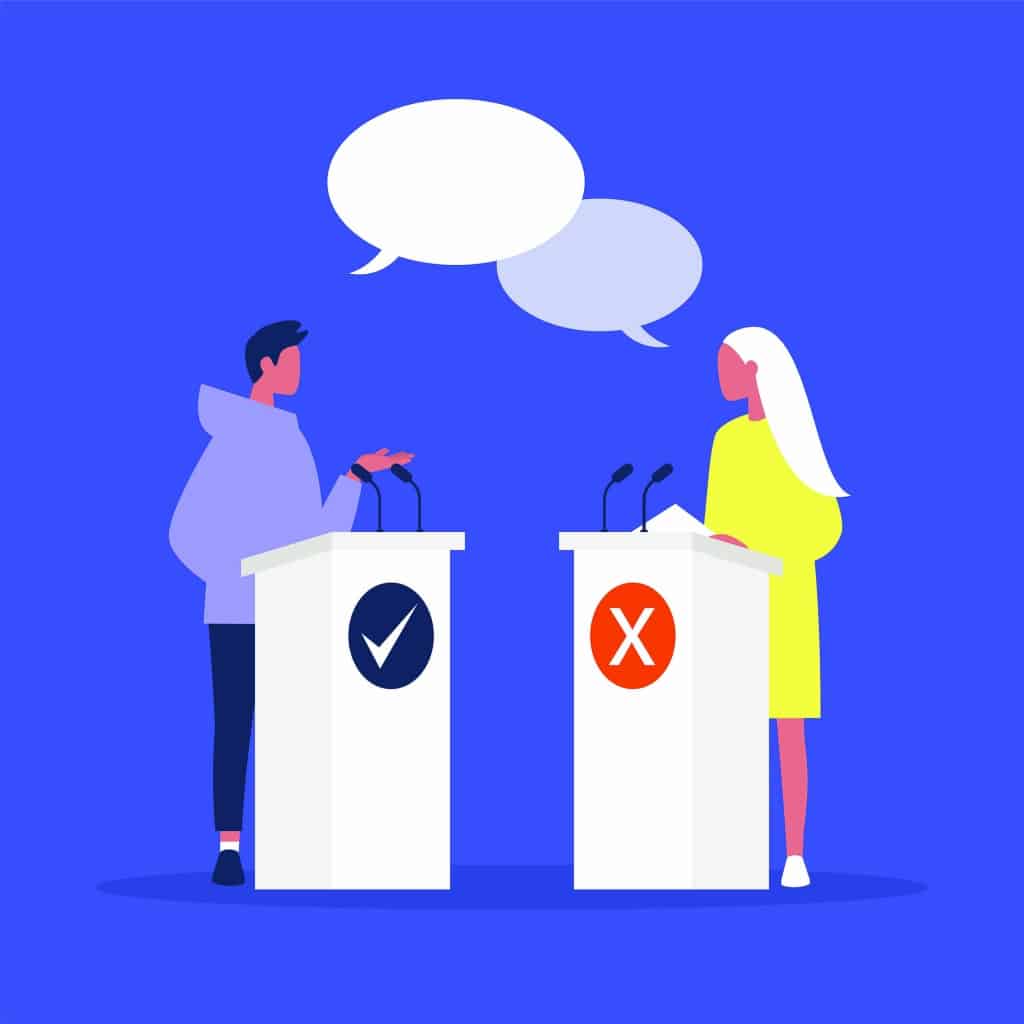
학교, 회사 회의, 패널 토론, 정치 단체 등 다양한 장소와 상황에서 토론을 활용할 수 있으므로, 토론의 주요 목적을 먼저 선택하는 것이 중요합니다. 이를 통해 계획을 명확하게 세우고 토론을 체계적으로 구성할 수 있습니다. 나중에 처리해야 할 세부 사항이 많기 때문에, 모든 세부 사항의 일관성을 유지해야 하기 때문입니다.
따라서 무엇보다도 먼저 진행자는 이에 대해 답변할 것입니다. 이 토론의 목표는 무엇입니까?
예를 들어 학생 토론목표는 수업 목표와 동일해야 하며, 학생들의 비판적 사고와 대중 연설 능력을 향상시키는 것이 될 수 있습니다. 수업 목표라면, 두 가지 아이디어 중 어떤 것을 선택할지 결정하는 것이 될 수 있습니다.
2. 구조가 선택됨
토론을 잘하려면 구조가 필요합니다. 토론 구조는 매우 다양하고, 그 안에도 여러 가지 형식이 있습니다. 토론을 준비하기 전에 여러 일반적인 토론 유형에 사용되는 기본 용어를 아는 것이 중요합니다.
- 주제 – 모든 토론에는 주제가 있으며 이를 공식적으로는 다음과 같이 부릅니다. 운동 or 분해능 주제는 진술, 정책 또는 아이디어일 수 있으며, 토론의 배경과 목적에 따라 달라집니다.
- 두 팀 - 긍정의 (모션 지원) 및 부정 (동의에 반대). 많은 경우에 각 팀은 XNUMX명의 구성원으로 구성됩니다.
- 심사 위원 or 심사위원: 증거와 토론자들의 수행으로 논증의 질을 판단하는 사람들.
- 시계 – 시간을 기록하고 시간이 다 되면 팀을 멈추는 사람.
- 관찰자 – 토론에 참관인(청중)이 있을 수 있지만, 참관인이 의견을 개진하는 것은 허용되지 않습니다.
초보자 토론의 경우 동의를 받은 후 팀이 준비할 시간을 갖습니다. 그만큼 긍정의 팀은 첫 번째 발표자와 함께 토론을 시작하고, 그 다음에는 해당 팀의 첫 번째 발표자가 토론을 시작합니다. 부정 팀. 그런 다음 두 번째 스피커로 이동합니다. 긍정의 팀, 다시 두 번째 발표자에게 부정 팀 등이 있습니다.
각 발표자는 토론 규칙에 명시된 정해진 시간에 자신의 요점을 발표하고 발표합니다. 아니라는 것을 명심하십시오 모든 토론은 팀으로 끝납니다. 부정; 때로는 팀 긍정의 끝내도록 요청할 것입니다.
아마도 여러분이 이 분야에 익숙하지 않을 것이므로 초보자를 위한 토론 과정을 찾을 수 있습니다. 이하따라하기 쉽고 다양한 유형의 토론에 사용할 수 있습니다.
3. 토론 계획 수립
토론이 원활하게 진행되기 위해서는 진행자가 다음과 같은 계획을 가지고 있어야 합니다. 최대한 자세하게이 계획을 알려줘야 합니다. 이 계획은 모든 것을 시각화하고 주제에서 벗어나지 않도록 도와줍니다. 초보자 토론에 참여할 때는 주제에서 벗어나는 게 정말 쉽거든요.
계획에 포함되어야 할 간단한 체크리스트는 다음과 같습니다.
- 토론의 목적
- 구조
- 방을 어떻게 꾸밀 것인가
- 각 기간의 타임 라인 및 타이밍
- 발표자와 심사위원을 위한 공식 토론 규칙 및 지침
- 메모 템플릿 역할을 위해
- 토론이 끝나면 토론을 마무리하는 요약
4. 방 정리
토론에 있어서 환경은 화자의 성과에 어느 정도 영향을 미칠 수 있으므로 필수적입니다.
토론은 최대한 전문적인 분위기 속에서 진행되어야 합니다. 토론장을 구성하는 방법은 여러 가지가 있지만, 어떤 방식을 선택하든 모든 것은 가운데에 있는 '발언자 구역'을 중심으로 이루어집니다. 바로 이 곳에서 토론의 마법이 펼쳐집니다.
두 팀을 대표하는 각 발표자는 자신의 차례가 진행되는 동안 발표자 구역에 서 있다가 끝나면 자리로 돌아갑니다.
아래는 인기 있는 레이아웃 예 초보자 토론:
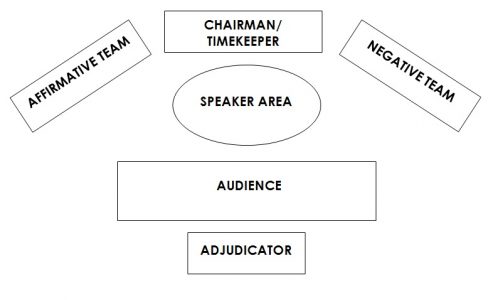
물론, 온라인 토론을 할 수 있는 방법도 있습니다. 온라인 초보자 토론에서는 같은 분위기를 느끼기 어려울 수 있지만, 토론 분위기를 더욱 즐겁게 만들 수 있는 몇 가지 방법이 있습니다.
- 배경 사용자 정의: 각 역할은 주최자, 계시원, 심판관 및 각 팀과 같이 Zoom 배경이 다를 수 있습니다. 이것은 각 참가자의 역할을 차별화하고 주어진 역할에 대한 자부심을 고취시키는 데 도움이 될 수 있습니다.
- 지원 장치:
- 시간제 노동자: 토론에서는 타이밍이 중요합니다. 특히 처음 접하는 초보자에게는 더욱 그렇습니다. 진행자는 화면 타이머를 사용하여 속도를 추적하기로 결정할 수 있습니다(대부분의 토론에서 계시원은 1분 또는 30초 남았을 때 신호를 보냅니다).
- 음향 효과: 이것은 초보자를 위한 토론일 뿐임을 기억하십시오. 진행자가 격려를 통해 분위기를 밝게 해줄 것을 기대할 수 있습니다. 박수 음향 효과 발표자가 연설을 마칠 때.
5. 팀 선택
팀은 다음으로 나뉩니다. 긍정의 및 부정. 일반적으로 팀과 해당 팀 내의 연사 위치는 무작위로 지정되므로 진행자가 다음을 사용할 수 있습니다. 스피너 휠 과정을 더 스릴 있고 매력적으로 만들기 위해.
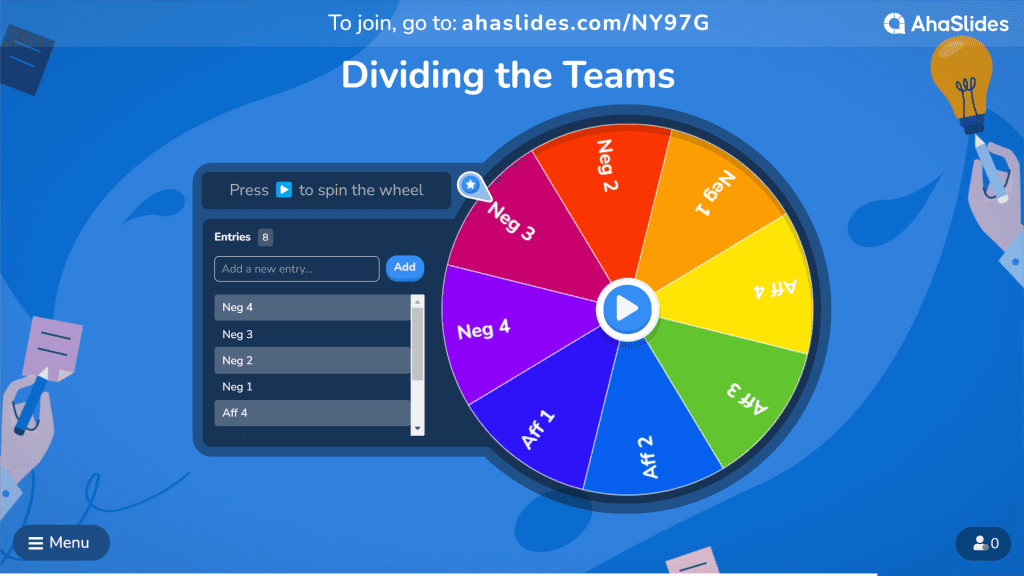
두 팀이 선정된 후, 동의안이 발표되고 준비할 시간이 주어지는데, 이상적으로는 1시간 정도가 소요됩니다.
이 시간에 진행자는 팀이 컨텍스트와 문제를 이해하여 더 강력한 요점을 만들 수 있도록 다양한 리소스를 지적할 것입니다. 알면 알수록 토론이 활발해집니다.
6. 논쟁의 시작
각각의 토론 유형에는 다른 형식이 필요하며 다양한 변형이 있을 수 있습니다. 다음은 초보자를 위한 모든 토론에 사용할 수 있는 매우 인기 있는 버전입니다.
이 토론에서는 각 팀이 6번씩 발언할 수 있으므로, 발언자는 8명 또는 6명이 하는 것이 가장 좋습니다. XNUMX명인 경우, 두 명의 토론자가 두 번씩 발언합니다.
| 스피치 병리학자 | Time | 토론자의 책임 |
| 1차 긍정적인 건설적 | 8 분 | 모션과 관점 소개 주요 용어에 대한 정의 제공 발의를 지지하는 그들의 주장을 제시 |
| 첫 번째 부정적인 건설 | 8 분 | 발의에 반대하는 그들의 주장을 진술하라 |
| 2차 긍정 건설적 | 8 분 | 동의안과 팀의 의견을 뒷받침하는 추가 주장을 제시합니다. 갈등 지역 식별 부정적인 화자의 질문에 답하십시오(있는 경우). |
| 두 번째 부정 건설적 | 8 분 | 동의안에 반대하는 추가적인 주장을 제시하고 팀의 의견을 강화합니다. 갈등 지역 식별 찬성하는 발언자의 질문에 답하십시오(있는 경우). |
| 첫 번째 부정적인 반박 | 4 분 | 방어하다 부정 팀의 주장을 반박하고 새로운 주장이나 정보를 추가하지 않고도 지지 주장을 반박합니다. |
| 1차 긍정 반박 | 4 분 | 방어하다 긍정의 팀의 주장을 반박하고 새로운 주장이나 정보를 추가하지 않고 반대 주장을 무너뜨립니다. |
| 두 번째 부정적인 반박 (결산문) | 4 분 | 두 번째 반박 및 마무리 진술을 하십시오. |
| 2차 긍정 반박 (결산문) | 4 분 | 두 번째 반박 및 마무리 진술을 하십시오. |
💡 규정에 따라 반론 전 준비 시간이 짧을 수 있습니다.
이 형식의 비디오 예를 볼 수 있습니다. 아래로.
7. 토론을 판단하다
이제 심판들이 활동할 시간입니다. 심판들은 각 토론자의 토론과 성과를 관찰하고 평가해야 합니다. 여러분의 발표에서 심판들이 살펴볼 몇 가지 사항은 다음과 같습니다.
- 조직 및 명확성 – 연설의 구성은 어떤가요? 당신이 한 방식으로 구성하는 것이 합리적인가요?
- 내용 – 당신이 제시하는 주장, 증거, 반대 심문, 반박.
- 전달 및 프레젠테이션 스타일 – 구두 및 신체 언어, 시각적 즐거움, 톤을 포함하여 요점을 전달하는 방식입니다.
새로운 토론자를 위한 10가지 팁
처음부터 모든 것을 완벽하게 마스터할 수는 없습니다. 살면서 토론을 해 본 적이 없다면 시작하기가 쉽지 않습니다. 아래는 10가지 빠른 팁 효과적으로 토론하는 방법을 발견하고 모든 토론에서 초보자와 함께 할 수 있습니다.
#1 - 준비가 핵심이다 – 주제를 조사하세요 많이 사전에 배경 정보뿐 아니라 자신감도 얻으세요. 이는 초보 토론자가 문제를 더 잘 이해하여 좋은 반박 시작자가 되고, 주장 초안을 작성하고, 증거를 찾고, 토끼굴에 빠지는 것을 피하는 데 도움이 될 수 있습니다. 모든 토론자는 아이디어를 더 잘 정리하고 연설의 '큰 그림'을 볼 수 있도록 모든 것을 요점(이상적으로는 3개의 주장에 대해 3점)으로 요약해야 합니다.
#2 - 모든 것을 주제로 유지 – 토론의 단점 중 하나는 주제에서 벗어나는 것입니다. 귀중한 발표 시간을 낭비하고 주장의 힘을 약화시키기 때문입니다. 개요와 주요 요점을 주의 깊게 살펴보고 주제를 잘 따르고 적절한 문제를 다루고 있는지 확인하세요.
#3 - 예를 들어 요점 만들기 – 예를 들면 토론 문장이 더 설득력 있게 되고, 사람들이 사물을 더 명확하게 볼 수 있게 됩니다. 이 아래 예를 보세요…
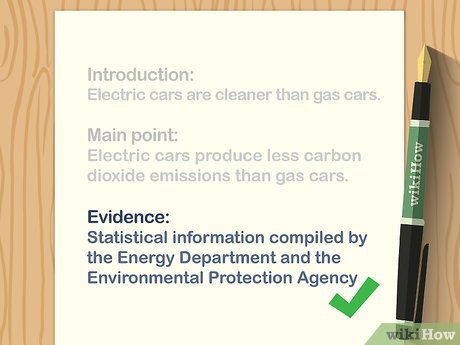
#4 - 상대방처럼 생각하려고 노력하라 – 아이디어를 수정하는 동안 상대방이 제기할 수 있는 쟁점을 생각해 보세요. 몇 가지를 파악하고 상대방이 제기할 경우 제시할 수 있는 반박 내용을 마인드맵으로 작성해 보세요. do 그 점을 끝내십시오.
#5 - 강력한 결론을 내리세요 – 적어도 주요 논점을 요약할 수 있는 몇 문장의 좋은 문장으로 토론을 마무리하세요. 많은 경우, 토론자들은 시적으로 잘 짜인 한 문장으로 강력하게 마무리하는 것을 좋아합니다. 마이크 드롭 순간 (아래에서 이에 대한 예를 확인하십시오.).
#6 - 자신감을 가지세요(또는 성공할 때까지 속이세요!) – 토론을 잘하는 데 가장 중요한 요소 중 하나는 분위기입니다. 토론자는 자신이 하는 말에 자신감을 가져야 합니다. 허세는 심판과 방청객에게 큰 영향을 미치기 때문입니다. 물론, 더 많이 준비할수록 자신감은 더 커집니다.
#7 - 천천히 말해 – 초보 토론자들이 흔히 겪는 문제는 말 속도입니다. 첫 번째 라운드에서는 대개 너무 빨라서 듣는 사람과 말하는 사람 모두 불안감을 느끼게 됩니다. 숨을 들이쉬고 천천히 말하세요. 전달력이 부족할 수도 있지만, 그 과정에서 나오는 메시지는 분명 의미심장할 것입니다.
#8 - 몸과 얼굴을 활용하라 – 바디 랭귀지는 당신의 주장을 뒷받침하고 자신감을 보여줄 수 있습니다. 상대방의 눈을 바라보고, 바른 자세를 유지하며, 표정을 잘 조절하여 (너무 공격적으로 행동하지 마세요) 관심을 사로잡으세요.
#9 - 잘 듣고 메모하기 – 토론자는 토론 속도를 유지하고, 팀원을 지원하고, 상대방을 더 잘 반박하기 위해 모든 발언과 아이디어에 주의를 기울여야 합니다. 반박하거나 더 자세히 설명해야 할 모든 요점을 기억할 수는 없으므로, 메모를 해 두면 많은 도움이 될 수 있습니다. 핵심 요점만 메모하세요.
#10 - 싼 샷을 피하십시오 – 상대방이 아닌 상대방의 주장에 집중하고 반박하세요. 어떤 토론자도 타인에게 불쾌감을 줘서는 안 됩니다. 이는 전문성 부족을 드러내는 것이며, 반드시 감점될 것입니다.
초심자 토론의 6가지 스타일
다양한 형식과 규칙을 지닌 다양한 스타일의 토론이 있습니다. 그 중 일부를 철저히 아는 것은 초보 토론자가 프로세스와 수행해야 할 작업을 파악하는 데 도움이 될 수 있습니다. 다음은 첫 번째 토론에서 볼 수 있는 몇 가지 일반적인 토론 스타일입니다!
1. 정책토론 – 이는 많은 조사가 필요한 일반적인 유형입니다. 토론은 특정 정책을 시행할지 여부를 중심으로 진행되며, 보통 두 명 이상의 팀으로 구성됩니다. 정책토론 많은 학교에서 사용되는데, 실용적이고 다른 유형보다 규칙을 따르기가 쉽기 때문입니다.
2. 의회 토론 – 이 토론 스타일은 영국 정부 모델과 영국 의회의 토론을 기반으로 합니다. 영국 대학에서 처음 채택되었으며, 현재는 세계 대학 토론 선수권 대회(World University Debating Championship)와 유럽 대학 토론 선수권 대회(European Universities Debating Championship)와 같은 여러 주요 토론 대회의 공식 토론 스타일입니다. 이러한 토론은 전통적인 토론보다 재치 있고 짧습니다. 정책 중학교에서 대학교에 이르기까지 많은 경우에 적합합니다.
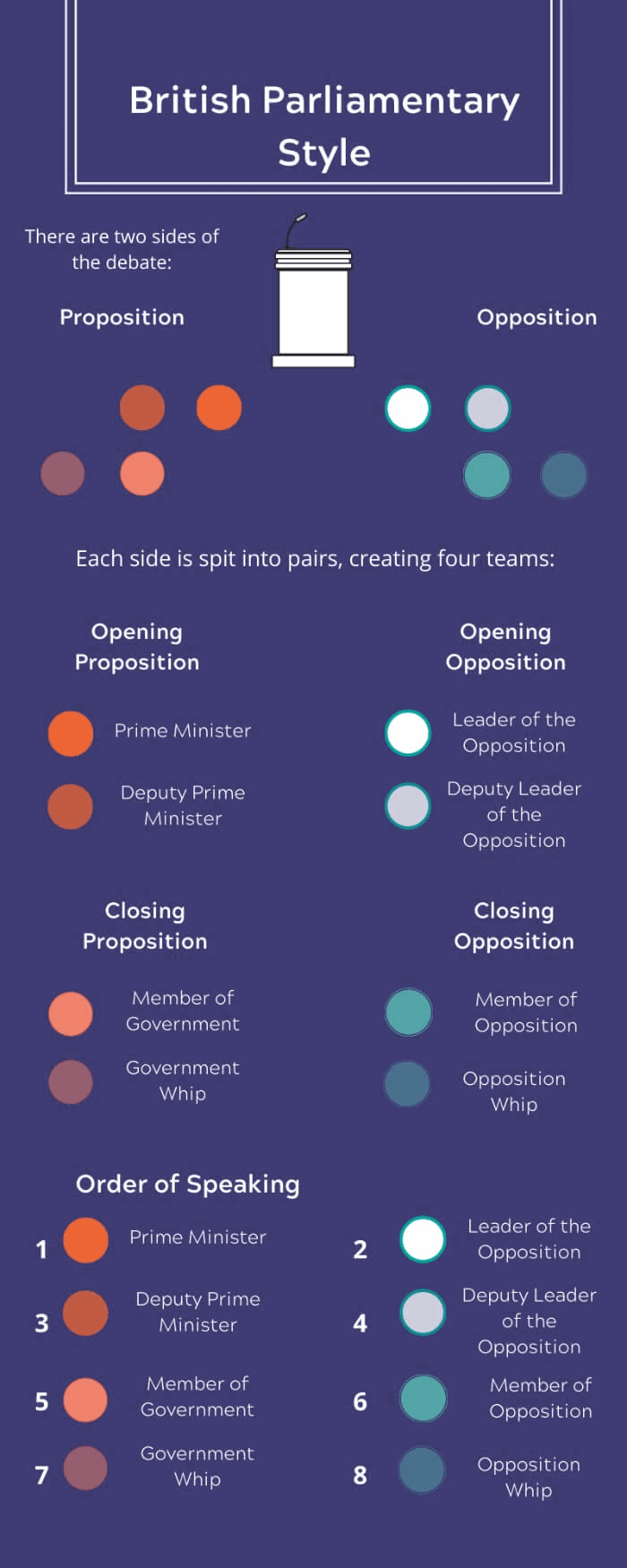
3. 공개 포럼 토론 – 이 스타일에서는 두 팀이 '핫'하고 논란이 많은 주제나 시사 이슈에 대해 토론합니다. 이러한 주제는 여러분이 이미 의견을 가지고 있을 가능성이 높은 주제이므로, 이러한 유형의 토론은 정책 토론.
4. 링컨 더글라스 토론하다– 1858년 미국 상원 의원 후보 에이브러햄 링컨과 스티븐 더글러스 간의 유명한 일련의 토론에서 이름을 따온, 개방적인 일대일 토론 스타일입니다. 이 스타일에서 토론자들은 주로 중요한 쟁점에 대한 더욱 심오하거나 철학적인 질문에 집중합니다.
5. 자발적인 입론 – 두 명의 토론자가 특정 주제에 대해 논쟁을 벌입니다. 짧은 시간 안에 자신의 주장을 펼치고, 별다른 준비 없이도 상대방의 의견에 빠르게 반응해야 합니다. 이는 강력한 논증 능력을 요구하며, 자신감을 키우고 무대 공포증을 극복하는 데 도움이 될 수 있습니다.
6. 의회 토론하다 – 이 스타일은 미국 의회를 시뮬레이션한 것으로, 토론자들이 의회 의원들을 흉내 내는 방식입니다. 그들은 법안(제안된 법률), 결의안(입장 표명) 등 여러 법안에 대해 토론합니다. 모의 의회는 법안 통과를 위해 투표하고, 법안에 대한 찬반 투표를 진행합니다.
2 토론의 예
여기서는 토론이 어떻게 일어나는지 더 잘 볼 수 있도록 두 가지 토론 사례를 보여드리겠습니다.
1. 영국 의회 토론
이 영상은 테레사 메이 전 영국 총리와 제러미 코빈 전 노동당 대표 간의 토론을 담은 짧은 영상입니다. 토론의 역동적인 분위기와 격렬한 논쟁은 이런 종류의 소란스러운 토론에서 흔히 볼 수 있는 특징입니다. 게다가 메이는 연설을 매우 강렬한 발언으로 마무리하여 화제가 되기도 했습니다!
2. 토론자들
학생 토론 학교에서 점점 더 인기를 얻고 있는 현상입니다. 잘 진행된 토론은 어른들의 토론만큼이나 흥미진진할 수도 있습니다. 이 영상은 영어 베트남어 토론 프로그램인 '디베이터스(The Debaters)'의 한 에피소드입니다. 이 고등학생들은 '그레타 툰베리에게 박수를 보냅니다(We applaud Greta Thunberg)'라는 안건에 대해 꽤 흔한 3대 3 형식으로 토론했습니다.






